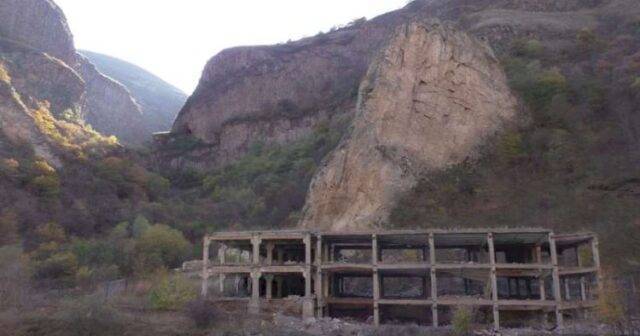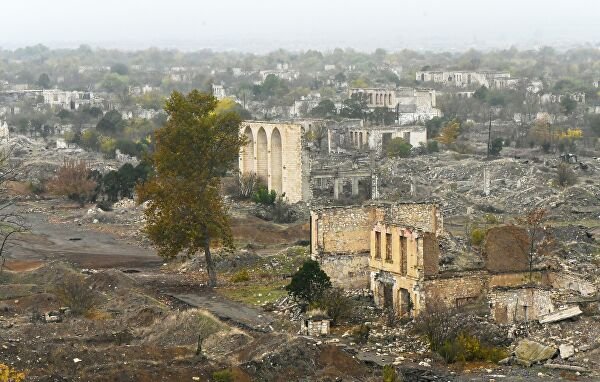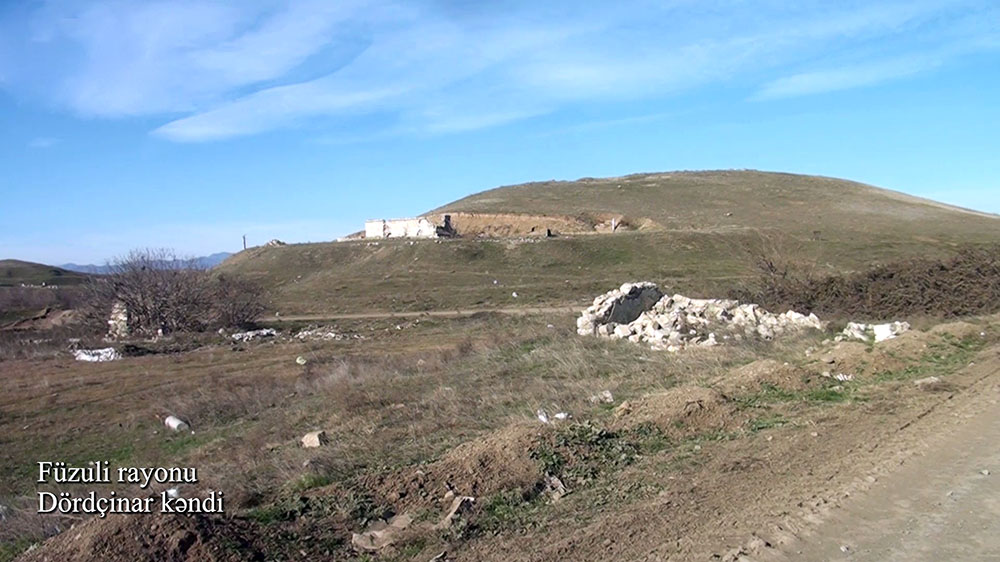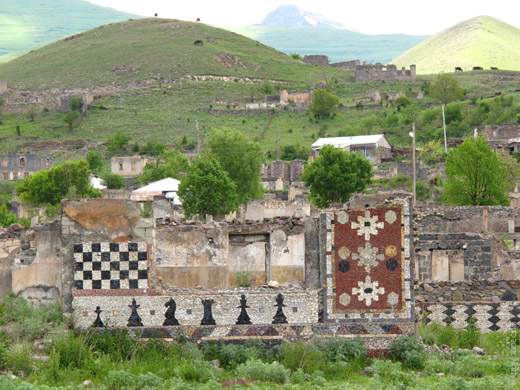DAMAGE TO NATURAL RESERVE POTENTIAL
Administrative districts of the Republic of Azerbaijan in Nagorno-Karabakh and surrounding Lachin, Kelbajar, Gubadli, Zangilan, Jabrayil, Aghdam (district center and a large part of its territory), Fuzuli (district center and a large part of its territory) were occupied by Armenia in 1989-1993.
 At that time, free smuggling and, in some cases, the transport of narcotic substances was carried out in the occupied sections of the borders of the Azerbaijan-Iran, which were left unattended. Construction materials of residential and public buildings, cut wood trees were transported from the occupied territories of Azerbaijan to Iran and Armenia.
At that time, free smuggling and, in some cases, the transport of narcotic substances was carried out in the occupied sections of the borders of the Azerbaijan-Iran, which were left unattended. Construction materials of residential and public buildings, cut wood trees were transported from the occupied territories of Azerbaijan to Iran and Armenia.
These 30-year-old occupied territories are very rich in various types of construction materials, which are of great importance in the industry and construction of Azerbaijan. A large number of such materials are located in the territory of Aghdam region Chobandagh (reserves of lime 140 million tons and clays 20 million tons), Shakhbulag (25 million tons of clay), Boyahmedli ( 45 million tons of clay), and other deposits. Large construction stone deposits are in Khankendi and marble is in Kharov.
163 types of mineral deposits, the reserves of which were confirmed before the occupation of our territories, including 5 gold, 7 mercury, 2 copper, 1 lead and sink, 1 coal stone, 6 clay-gypsum formations, 4 vermiculite, 1 raw material for soda production,12 non-ferrous and ornamental stones ( obsidian, marbled onyx, jasper, etc.), 10 building stones, 21 facing stones, 9 clay, 20 types of cement raw, 8 different types of building stones, 6 lime raw, 10 sand-gravel, 4 construction sand, 1 perlite, 8 pumice-volcanic ash, 16 underground freshwater deposits, and 11 mineral water deposits.
In general, in the territories occupied by the Armenian Armed Forces of the Republic of Azerbaijan, 561 deposits, manifestation, and a promising area of mineralization were identified. Geological exploration should be carried out here in order to assess the industrial significance and prospects of the existing reserves of ore and non-core mineral deposits. The mineral waters of the İstisu located on the territory of the Kalbajar region are especially different from their favorable gas and chemical composition, high temperature, and large natural reserves. Its waters can be treated with both external and internal human diseases. A large resort and mineral water plant were built on the Istisu in the 80s. The plant produced 800 thousand liters of water per day.
For centuries, the mountainous part of Karabakh was in close economic relations with Nagorno-Karabakh. The roads along the river valleys have connected these two areas economically. Unlike all these historical and geographical realities, the capture of Upper Karabakh by Armenians and its forced departure from Karabakh created very serious problems for the population and economy of the region.
ECOLOGICAL PROBLEMS IN THE OCCUPIED TERRITORIES
 Heavy military equipment moving in the occupied mountainous areas, large quantities of shells, suppressed mines cause strong damage to the soil cover and vegetation of these territories.
Heavy military equipment moving in the occupied mountainous areas, large quantities of shells, suppressed mines cause strong damage to the soil cover and vegetation of these territories.
Plane forests cover 100 hectares of the Basitchay State Reserve located in the Zangilan region. There are also mixed plane trees. There are Greek walnut, daghdaghan, mulberry, willow, populus trees, hawthorn, rosehip, buckthorn, paliurus shurbs develop. The average age of plane trees in the land is 165 years, the average height is 35 m, the average diameter is 1 m, their age is 1200-1500 years, there are also specimens reaching 50 m in height and 4 m in diameter. Forest reserves are 190 m3 per nectar for a total area of 16,200 m3. Annual forest growth reaches 1.22 m3 per 1 ha.
Unfortunately, such wealth was destroyed during the occupation, cut and used in the production of furniture.
Realizing that in these territories temporarily, the Armenians brutally used natural resources there and mineral deposits. Easy to use mineral water, various technical materials, reserves, more mastered. According to the statement, the Armenians who left Lachin and Kalbajar committed fires in those areas. This fire caused serious damage to those areas from an ecological point of view.
The ecological environment in these territories has become more and more severe because of the fact that the illegal entity Nagorno-Karabakh bears no responsibility to the international organizations on the protection of ecological conditions in the occupied territories.
LOSSES CAUSED BY SOCIO-PSYCHOLOGICAL AND ECONOMIC SITUATION OF POPULATION OF AZERBAIJAN
 Only in 1988-1989, when the conflict escalated, 250,000 Azerbaijanis from 22 districts of the Republic of Armenia were forced out of their native lands and brought refuge to Azerbaijan. 410 Azerbaijanis, including 57 women, 23 children, who were tortured by Armenian executioners during the same period of their resettlement, were brutally murdered, received various bodily threats, their houses and estates were robbed. As a result, 9 thousand square kilometers of the territory in which Azerbaijanis lived were captured in Armenia.
Only in 1988-1989, when the conflict escalated, 250,000 Azerbaijanis from 22 districts of the Republic of Armenia were forced out of their native lands and brought refuge to Azerbaijan. 410 Azerbaijanis, including 57 women, 23 children, who were tortured by Armenian executioners during the same period of their resettlement, were brutally murdered, received various bodily threats, their houses and estates were robbed. As a result, 9 thousand square kilometers of the territory in which Azerbaijanis lived were captured in Armenia.
In the period between 1989-1998 in all the occupied regions, birth fell sharply, death increased partially, and natural growth decreased excessively for every 1000 people. One of the most painful problems of refugees and IDPs was the difficulties associated with their employment.
Thus, as a result of the aggression of Armenia more than 1 million refugees and IDPs were formed, 20 thousand people became dead, 50,000 people became disabled, 5100 people (until June 1, 1992) were captured and disappeared, the natural growth of the population in the occupied regions decreased.
DAMAGE TO INDUSTRIAL, RESIDENTIAL, AND SOCIAL FACILITIES

As a result of the occupation, all these material and technical bases for new construction were destroyed and the planned projects were not implemented. The industrial areas operating in the occupied territories occupied an important place in the economy of the Republic. Here, enterprises in the food, light, building materials industries were more developed.
The development of these areas in the region had a positive impact on agriculture and local natural resources. The most powerful development of the industrial areas of the occupied territories was oil-cheese, winemaking, and, in part, light industry, which was of great importance for the provision of the local population.
Strong communication lines and facilities were established in the region. Roads with a total length of 25 thousand km, 160 bridges with a total length of 3984 meters, power lines with a length of 14 500 km, 2500 transformations, 2300 km water pipeline lines, gas pipeline with a total length of 2 thousand km, sewage lines with a total length of 240 km, 160 water meters, more than 34 gas distribution facilities, 35,000 telephone stations, 4 airports, Baku-Aghdam and Horadiz-Ordubad railway lines, Baku-Stepanakert-Nakhichivan gas pipeline, etc. Were destroyed.
There were more than 310 industrial and construction facilities in the regions occupied by Armenia. These facilities produced 11% of wall materials in Azerbaijan, 11% of footwear production, 25.2% of cow oil, 35% of wine materials, 13.5% of raw silk, 15% of mineral water, etc.
DAMAGE TO AGRICULTURE IN THE REGION
 The Upper Karabakh zone is a major agricultural region of Azerbaijan. The occupied part of the Lesser Caucasus, which has favorable intermountain and upland plains and flat surface pastures and is well wet, created great opportunities for the development of crop production and livestock farming. The composition of agriculture was dominated by grain, fodder production, viticulture, tobacco, potato growing, cotton growing, horse breeding, and especially sheep breeding.
The Upper Karabakh zone is a major agricultural region of Azerbaijan. The occupied part of the Lesser Caucasus, which has favorable intermountain and upland plains and flat surface pastures and is well wet, created great opportunities for the development of crop production and livestock farming. The composition of agriculture was dominated by grain, fodder production, viticulture, tobacco, potato growing, cotton growing, horse breeding, and especially sheep breeding.
As a result of Armenia's aggression, many agricultural enterprises operating on this territory, including collective farms, state farms, economic associations, and agricultural companies, ceased their activities.
Thus, since 1988, 311 agricultural enterprises, 145 newly created viticultural and wine-growing state farms equipped with modern equipment have been destroyed in the occupied territories, and, in particular, the Aghdam horse-breeding state farm, which raises the famous Karabakh horse breeds, 135 collective farms and 31 inter-farm enterprises.
1,365 trailers and 3,425 different landing and trailer tractors, which form the material and technical base of agriculture and are unable to purchase farmers at current prices, harvesters collecting grain and cotton, etc., remained in the occupied territories.
In the occupied territories there remained 7,296 units of hydro-cities, 36 pumping stations, 26 units of irrigated systems, 18 units of head structures of the irrigation system, 1,200 km of inter-farm irrigation canals, 5600 km of economic systems, 127.7 thousand hectares of quality irrigated land. As a result of the destruction of land in the low-lying Caucasus region, millions of people were deprived of their main source of livelihood-land.
During the occupation, 311 agricultural enterprises, including 145 newly established viticulture-winemaking, 1365 cars, 3425 agricultural and trailer tractors, 7296 hydro-turbines, 62 water pumps and irrigation aggregates, 1200 km of inter-farm irrigation canals, 645.5 thousand hectares of agricultural lands, 185.5 thousand hectares of arable lands, 40,000 hectares of young vineyards were destroyed, Annually, an average of 79.4 thousand tons of grain, 20.5 thousand tons of cotton, 324.3 thousand tons of grapes, 23.5 thousand tons of potatoes, etc. crop products not collected as a result of the occupation, more than 313.1 thousand heads of cattle, including 111.2 thousand cows and feed, 1 million 98 thousand sheep and goats were looted and 20 thousand tons of meat, 75.5 thousand tons of milk, 846 tons of annual livestock products were lost.
MATERIAL AND MORAL DAMAGE TO AZERBAIJANI CULTURE
As a result of military aggression, one of the first human settlements in the occupied territories, the famous Azikh and Taghlar caves, Garakopak and Uzarliktepe gorgans were used for military purposes, along with the gorgans in Khojaly, Aghdam, Aghdara, Jabrayil districts, Cemeteries, tombs, tombstones, mosques, temples, monuments belonging to Caucasian Albania and other national monuments in the territories of Shusha, Lachin, Kelbajar, Gubadli, Zangilan, Fuzuli regions have been destroyed.
The only one in the former USSR, the Agdam bread museum was razed to the ground during the bombardment of the city, up to 13,000 items of the world Shah Kelbajar Museum of history and local studies, more than 5,000 items of the Lachin Museum of history and local studies were transported to Armenia.
As a result of the occupation of Shusha, our spirituality was severely damaged. Only in Shusha 8 museums, 31 libraries, 17 clubs, 8 Culture houses were destroyed.
About 5,000 items of the Museum of history of the city of Shusha, about 1000 objects of the State Museum of Azerbaijani carpet and folk Applied Art, About Shusha branch, State Museum of Garabagh History, founder of professional Azerbaijani music, composer Uzayir Hajibeyov (more than 300 objects), Our vocal art is based on the memorial museums of the great singer Bulbul (400 objects), the outstanding musician and artist Mir Movsum Navvab (more than 100 objects), the Agdam Museum of history and ethnography (more than 2 thousand objects), The funds of the Gubadli Museum of History and ethnography (more than 3 thousand objects), the Zangilan Museum of History and ethnography (up to 6 thousand objects) were laid. Memorial museum of prominent Azerbaijani musician Gurban Pirimov in Aghdam region, History and ethnography museums of Jabrayil, Fizuli and Khojaly regions were also destroyed.
In the occupied territories there are more than 2,600 historical and cultural monuments, 706 of which are registered in the state, most of which have been destroyed or appropriated. Of the state-registered monuments, 6 of them are World-important architecture, 5 of them are World-important archaeological, 119 of them are Country-important architecture, 121 of them are Country-important archaeological, 393 of them are local-important architecture, 23 of them are Garden-park, monumental and Memorial, 22 of them are local-important archaeological monuments, 17 are examples of decorative-applied art.
The funds of the art galleries of Shusha, Lachin, and Gubadli, consisting of works by prominent artists and sculptors of Azerbaijan, were destroyed.
Having shown the cruelty of the Armenian aggressors, major figures of Azerbaijani music Uzeyir Hajibeyov and Bulbul, as well as the poet Khurshudbanu Natavan, took the sculptures from the city of Shusha to the territory of Armenia. These statues, returned to Azerbaijan in exchange for money, after the victory was taken to their homeland-to Shusha.
It is almost impossible to determine the value of these monuments with the destroyed ancient, invaluable cultural wealth of the Azerbaijani people.
The establishment and deliberate destruction of historical and cultural monuments of Azerbaijan as a result of the aggression of Armenian occupiers is contrary to the 1954 Hague Convention "on the protection of cultural values in the event of armed conflict", 1992 European Convention "on the protection of archaeological heritage", 1972 UNESCO Convention "on the protection of World Cultural and natural heritage".
But we will revive our native lands again. Again, life in those charming corners will be revived and all the countries of the world will witness it. The whole of Azerbaijan will be united as a fist on the front and back, and will soon raise up every inch of its lands, longing for its people, as it freed its ancient lands from the vile enemy!



